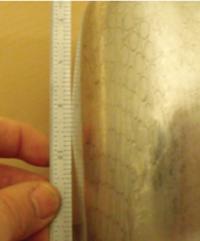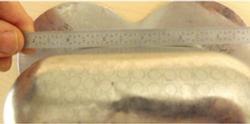Contributing Writer
- FMA
- The Fabricator
- FABTECH
- Canadian Metalworking
Categories
- Additive Manufacturing
- Aluminum Welding
- Arc Welding
- Assembly and Joining
- Automation and Robotics
- Bending and Forming
- Consumables
- Cutting and Weld Prep
- Electric Vehicles
- En Español
- Finishing
- Hydroforming
- Laser Cutting
- Laser Welding
- Machining
- Manufacturing Software
- Materials Handling
- Metals/Materials
- Oxyfuel Cutting
- Plasma Cutting
- Power Tools
- Punching and Other Holemaking
- Roll Forming
- Safety
- Sawing
- Shearing
- Shop Management
- Testing and Measuring
- Tube and Pipe Fabrication
- Tube and Pipe Production
- Waterjet Cutting
Industry Directory
Webcasts
Podcasts
FAB 40
Advertise
Subscribe
Account Login
Search
Preventing oil canning problems
- By Art Hedrick
- March 9, 2010
- Article
- Bending and Forming
I have spent a great deal of time on die building and stamping jobs, dealing with everything from soup to nuts. What I find most frustrating are die shops and stampers that waste a great deal of money trying to correct oil canning problems rather than trying to prevent them so they don't have to be corrected later.
Recently I was in a die shop that was driven by its customer to correct an oil canning problem by reshaping the metal. After days of refitting and respotting the dies at its own expense, the shop proved to the customer that the problem could not be corrected by trying to coin, beat, or reshape the metal, but it could be prevented. Preventing the oil canning would require a larger blank so that the part could be stretch-formed. The customer rejected this idea. The battle continues, with both parties losing.
What Is Oil Canning?
If you ever have had a stamped part that snaps into more than a single rigid position, welcome to oil canning! Imagine an old-fashioned oil drum. If you pushed on the slightly curved bottom hard enough, it would pop into the reverse shape—hence the name oil canning.
Very simply, oil canning is the result of uneven metal flow during a drawing operation. It often can be seen in the walls of deep-drawn square or rectangular shells (see Figure 1a and Figure 1b), caused by the imbalance of metal flow into the drawing cavity (see Figure 2). Unstrained or loose metal in a stamping can result in an oil canning effect. Oil canning also can be present as a two-position twist in a part.
Strain, Strain, Strain
For metal to take a given shape, it must be permanently plastically deformed. End of story. If you don't deform the metal enough, it will not change its shape. This deformation is known as plastic strain.
For example, if you grab a simple playing card and bow it up slightly and release it, it will return to its original flat shape. Only when you bend the card a great deal does it begin to take the curved shape.
Keep in mind that metal can be strained via tension or compression. In other words, it can be stretched or squeezed. The key is to get deformation that is permanent.
The Correction Attempt
Unless the metal is very thick, in which case oil canning would be less likely, forget trying to flatten the area using pressure. For example, let's say that you are trying to straighten or flatten the wall of the drawn rectangular shell shown in Figure 1 by hitting the drawn part surface with a flat-faced cam. For the wall to change its shape permanently, the metal must be plastically deformed.
To permanently deform the stainless steel using compression will take about 200 tons per square inch. The wall is about 24 sq. in., so 4,800 tons of pressure (24 x 200) will be required to flatten one wall. Keep in mind that the part has four walls, so you'll need 19,200 tons (4,800 tons x 4) of pressure—that's 38,000,000 lbs.! I hope you have a big press.
Even if you do have a press that's big enough to deliver that kind of pressure, the tool steel and cams probably won't take the pressure and will most likely explode upon part impact. The truth is that no matter how well the die is spotted in, and no matter how hard you hit the surface, you most likely will not remove or improve the oil canning problem.
Prevention Is Better Than Cure
The key is to keep oil canning from happening in the first place. There are many solutions to oil canning, all of which require stretching the metal to instill strain.
For example, the drawn part in Figure 3 has straight corners and bowed side walls. The metal in the corners of the part is forced into radial compression, which creates a resistance to flow and results in more stretch occurring in the corners of the part. However, the side walls are not subject to radial compression, so there is little resistance to flow; the metal is simply being bent and unbent as it flows into the drawing cavity.
To stretch the metal in the side walls, you have to create a resistance to flow. One of the most common ways to accomplish this is to add a draw bead to the die. The draw bead serves as a radial "speed bump" that forces the metal to bend and unbend before it enters the cavity. Adding a draw bead will reduce the metal flow into the walls of the part, resulting in a flat, straight wall (see Figure 3).
Metal Gainers and Draw Bars
Adding a draw bead is not always the best solution, however. For parts that have significant metal flow differences from one area to another, it is sometimes necessary to equalize the metal consumption by adding a feature to the part geometry that consumes and stretches any extra material that is causing oil canning.
This feature is a metal gainer or draw bar. Typically, a metal gainer is placed on the inside of a part, while a draw bar is on the outside of the finished part.
The key to solving oil canning problems is to strain the metal using tension and to do so as evenly and as much as possible. Avoid the "I'll get it out in the next operation" concept. Once oil canning is present, it is difficult for you to remove it. Prevent it from happening by addressing the root cause.
About the Author

Art Hedrick
10855 Simpson Drive West Private
Greenville, MI 48838
616-894-6855
Related Companies
subscribe now

The Fabricator is North America's leading magazine for the metal forming and fabricating industry. The magazine delivers the news, technical articles, and case histories that enable fabricators to do their jobs more efficiently. The Fabricator has served the industry since 1970.
start your free subscription- Stay connected from anywhere

Easily access valuable industry resources now with full access to the digital edition of The Fabricator.

Easily access valuable industry resources now with full access to the digital edition of The Welder.

Easily access valuable industry resources now with full access to the digital edition of The Tube and Pipe Journal.
- Podcasting
- Podcast:
- The Fabricator Podcast
- Published:
- 04/16/2024
- Running Time:
- 63:29
In this episode of The Fabricator Podcast, Caleb Chamberlain, co-founder and CEO of OSH Cut, discusses his company’s...
- Trending Articles
Tips for creating sheet metal tubes with perforations

JM Steel triples capacity for solar energy projects at Pennsylvania facility

Are two heads better than one in fiber laser cutting?

Supporting the metal fabricating industry through FMA

Omco Solar opens second Alabama manufacturing facility

- Industry Events
16th Annual Safety Conference
- April 30 - May 1, 2024
- Elgin,
Pipe and Tube Conference
- May 21 - 22, 2024
- Omaha, NE
World-Class Roll Forming Workshop
- June 5 - 6, 2024
- Louisville, KY
Advanced Laser Application Workshop
- June 25 - 27, 2024
- Novi, MI




























